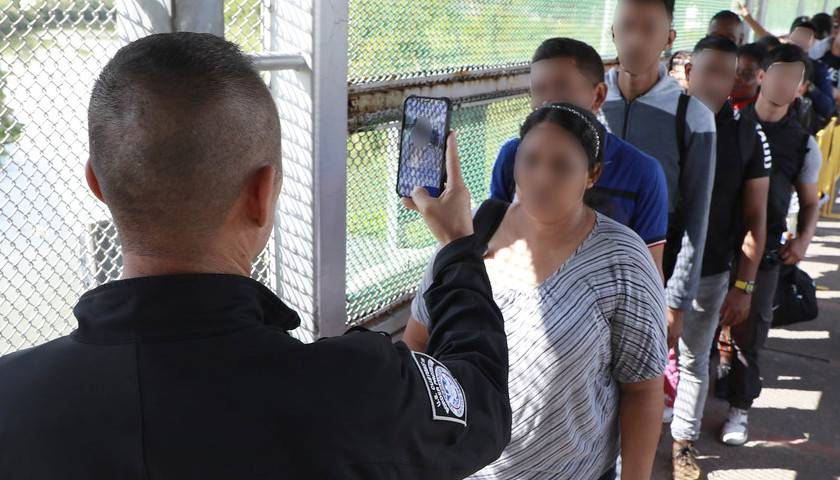by Bethany Blankley
Federal, state and city health departments have issued public health alerts about increases of communicable diseases as illegal border crossers arrive in their communities.
Earlier this year, the New York City Health Commissioner instructed New York health-care providers to undergo several precautions and tests in light of “an alarming trend” of diseases spreading among illegal foreign nationals in New York City who arrived from the southern border. Dr. Ashwin Vasan expressed alarm about those arriving who hadn’t been vaccinated for polio or chickenpox and were coming from countries with high rates of infectious tuberculosis.
“Many people who recently arrived in NYC have lived in or traveled through countries with high rates of TB,” he wrote in an April 11 letter to physicians and health care providers.
The CDC also issued an alert around the same time, saying, “For the second year in a row, TB disease cases in the U.S. have continued to rise, with concerning increases among young children and other groups at increased risk for TB disease.” Cases presenting in children aged 4 and under was “particularly concerning because they usually result from recent transmission versus reactivation of long-standing latent TB infection,” it said.
The Chicago Department of Public Health recently issued a public health alert about an increase in chickenpox (varicella) cases, “especially in the last four weeks.”
“Most cases have been in people newly arrived from the U.S. southern border living in shelters,” accounting for 81% of the new cases, the alert said; 90% involved unvaccinated individuals.
CDPH Commissioner Dr. Simbo Ige said those arriving and spreading the disease are from countries where administering chickenpox vaccines “isn’t routine.”
Nearly 400 chickenpox cases were reported since January 1, CDPH said—up from a median of 53 cases reported a year from 2005 to 2022.
The CDPH instructed public schools to ensure that “incoming students are vaccinated against chickenpox according to the IDPH minimum immunization requirements for schools” and to report all confirmed chickenpox cases to CDPH within 24 hours.
The Illinois Department of Public Health also launched a new phone line for syphilis consultations after the number of congenital syphilis cases in Illinois have nearly tripled since 2021. The Perinatal Syphilis Warmline (1-800-439-4079) was launched to provide clinical consultation for providers who treat pregnant women and newborns, among other services.
The IDPH is also encouraging medical providers “to increase syphilis testing of all individuals – especially pregnant people – in any medical setting, including urgent care, emergency departments, and all prenatal care settings.”
The CDC just announced that the number of congential syphilis cases in the U.S. “is increasing at an alarming rate” and “at the highest level in at least 30 years.” In 2022, a total 3,761 congenital syphilis cases were reported to the CDC, including 231 stillbirths and 51 infant deaths. Put another way, the number of babies born with syphilis in 2022 was over 10 times the number reported in 2012, the CDC said. Congenital syphilis cases in the U.S. increased by 755% during 2012–2021.
Prior to this outbreak, a Journal of Immigration and Minority Health analysis of syphilis screening results for all U.S.-bound refugees from January 1, 2009, through December 31, 2013, found that 874 tested positive out of 233,446. “The highest overall age-adjusted prevalence rates of syphilis seropositivity were observed among refugees from Africa (1340 cases per 100,000), followed by East Asia and the Pacific (397 cases per 100,000).”
In California, the CDPH issued an alert about a recent increase in monkeypox cases being reported statewide and encouraged Californians “to be aware of the signs and symptoms of mpox and to take preventive measures, including vaccination, to protect against severe illness.”
The CDC also issued a health alert warning about Mpox with a geographic spread in the Democratic Republic of the Congo. “Clinicians should notify their state health department if they have a patient with mpox-like symptoms, which may include a diffuse rash and lymphadenopathy, and recent travel to DRC,” it said.
Not all communicable diseases are being reported in refugee, asylum, or immigrant communities, but Democratic lawmakers in Texas border communities have raised concerns about illegal border crossers creating a public health crisis over the last few years.
Laredo officials sued the federal government after COVID-positive illegal border crossers were released into their town and an outbreak occurred. McAllen officials were inundated with 7,000 COVID-positive illegal border crossers at one time, creating a public health crisis and exorbitant cost to taxpayers. Democratic lawmakers’ calls for the president to close the border over public health concerns went unanswered.
According to the CDC, refugees and asylum seekers are not required to comply with vaccination requirements before coming to the U.S. However, they must comply when they apply to become Lawful Permanent Residents. The agency “strongly recommends” vaccines for refugees and asylum seekers “to protect against vaccine-preventable diseases, avoid delays in movement, and because school-aged children may be required to meet school-entry vaccination requirements upon school enrollment in the United States.” It also published a recommended, not mandatory, vaccination program for them, including an immunization schedule.
– – –
Bethany Blankley is a contributor to The Center Square.




